Special Report
20 American Ghost Towns
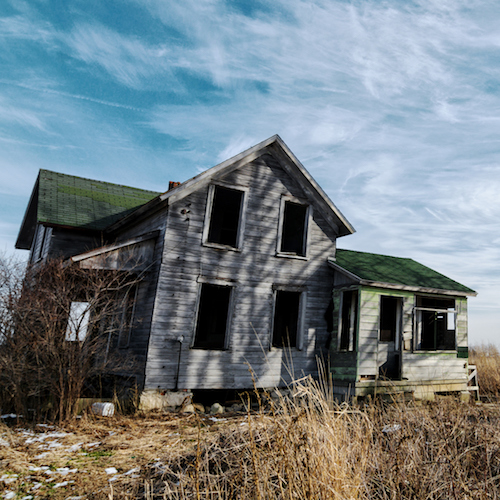
Published:
Last Updated:

The U.S. housing market has recovered substantially since the housing crisis. The improvement, however, has been uneven, and in many U.S. cities housing markets continue to struggle. In some, property values and foreclosure rates have even worsened. In such cases, many homeowners find they have no choice but to abandon their property.
Property data company ATTOM Data Solutions compiled information provided by mail carriers in some 26,000 zip codes. 24/7 Wall St. combined zip code data to gather housing characteristics for more than 5,000 U.S. cities — including vacancy rates. Nationwide, an estimated 1.6% of all residential properties have been flagged as vacant by mail carriers, according to recent figures released by real estate data tracking firm RealtyTrac.
[in-text-ad]
Indian Rocks Beach, Florida leads the nation in vacancy with 26.1% of housing units flagged as abandoned. Blackwell, Oklahoma rounds out the 20 cities with the highest vacancy rates with 10.0% of homes abandoned.
Click here to see the 20 American ghost towns.
A significant share of these housing markets are part of metropolitan areas in the Rust Belt — suburbs in and around cities like Detroit and St. Louis, as well as smaller cities like Gary, Indiana. These are places that lost hundreds of thousands of jobs – and consequently residents — as the U.S. manufacturing sector declined in the second half of the last century.
Daren Blomquist, senior vice president at ATTOM Data Solutions, spoke to 24/7 Wall St. “Places like Gary and Detroit are areas which over the last few decades have experienced a decrease in population, and an outflow of population means you end up with an oversupply of housing.” Blomquist added that in these Midwestern cities, a disproportionately large share of available properties are older — built in the 1950s and 60s. They are therefore less desirable to potential buyers and more likely to remain vacant as a result.
The subprime housing crisis took a toll on much of the American housing market. But while many U.S. cities have recovered by this point, a number of cities on this list have not. Poverty and home values in these cities remain similar to levels during the crisis — or worse. In a number of Detroit-area towns on this list, for example, home values are more than 40% below their values five years prior. Blomquist explained, “They’ve been left behind by the housing recovery that many other parts of the country have experienced.”
As further evidence of the link between poor economies and home vacancy, more than half of the 20 cities on this list have poverty rates at least double the national rate of 15.6% of the population.
To identify the 20 cities with the highest vacancy rates, 24/7 Wall St. reviewed the percentage of residential properties flagged as vacant by postal carriers in 26,864 zip codes provided by Attom Data Solutions as of the end of the third quarter of 2016. We aggregated zip code data to the city level by combining housing characteristics for zip codes located in U.S. cities. Cities with fewer than 2,500 residential properties were excluded from our analysis. It is unusual for postal carriers to flag vacation homes as vacant. However, we attempted to eliminate the towns where vacated homes were likely second homes and not truly abandoned. Foreclosure rates, the percentage of vacant properties with open loans, in foreclosure, and bank owned were also provided by Attom Data Solutions. Social and economic data, including population estimates, poverty rates, median household income, and median home values are five-year averages through 2014 from the U.S. Census Bureau’s American Community Survey (ACS). Population and home value changes were calculated using five-year averages through 2009. These are the latest and most accurate data for the cities reviewed.
These are 20 American ghost towns.
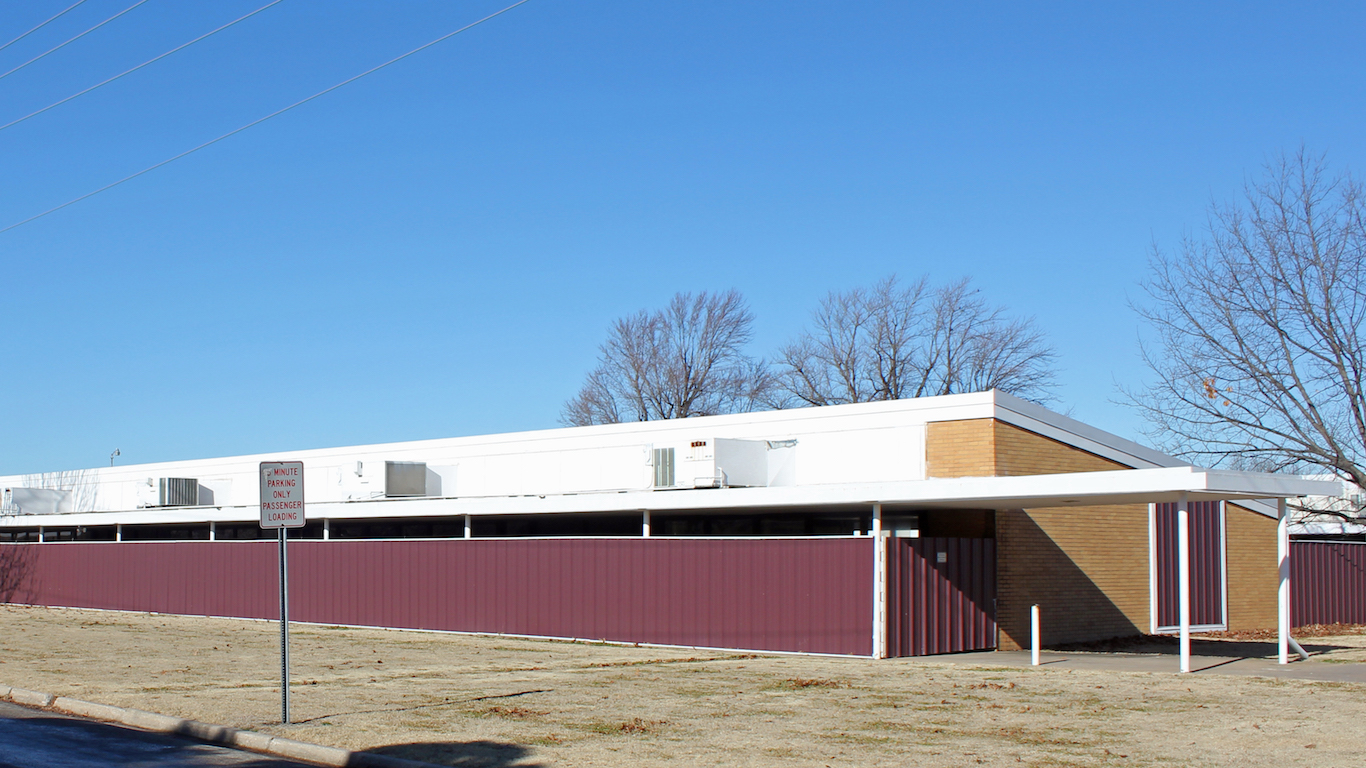
20. Blackwell, Oklahoma
> Vacancy rate: 10.0%
> Vacant properties: 363
> 5 yr. population change: -3.5%
> Median home value: $48,600
In the town of Blackwell, Oklahoma about one in every 10 homes are vacant. Founded in the late 19th century, Blackwell thrived due to its location on the St. Louis and San Francisco Railway. The town operated as a trading hub for a variety of agricultural products. At one point, Blackwell was home to a variety of companies and manufacturers, including several glass factories. According to the Oklahoma Historical Society, the town’s population peaked in 1960 at 9,588 but then began to decline. As of the 2014, the town had just under 7,000 residents.
[in-text-ad]
As is the case with so many towns with a large share of abandoned residential properties, real estate in Blackwell is inexpensive. The typical home in the metropolitan area costs just $48,600, less than a third of the national median home value of $175,700.
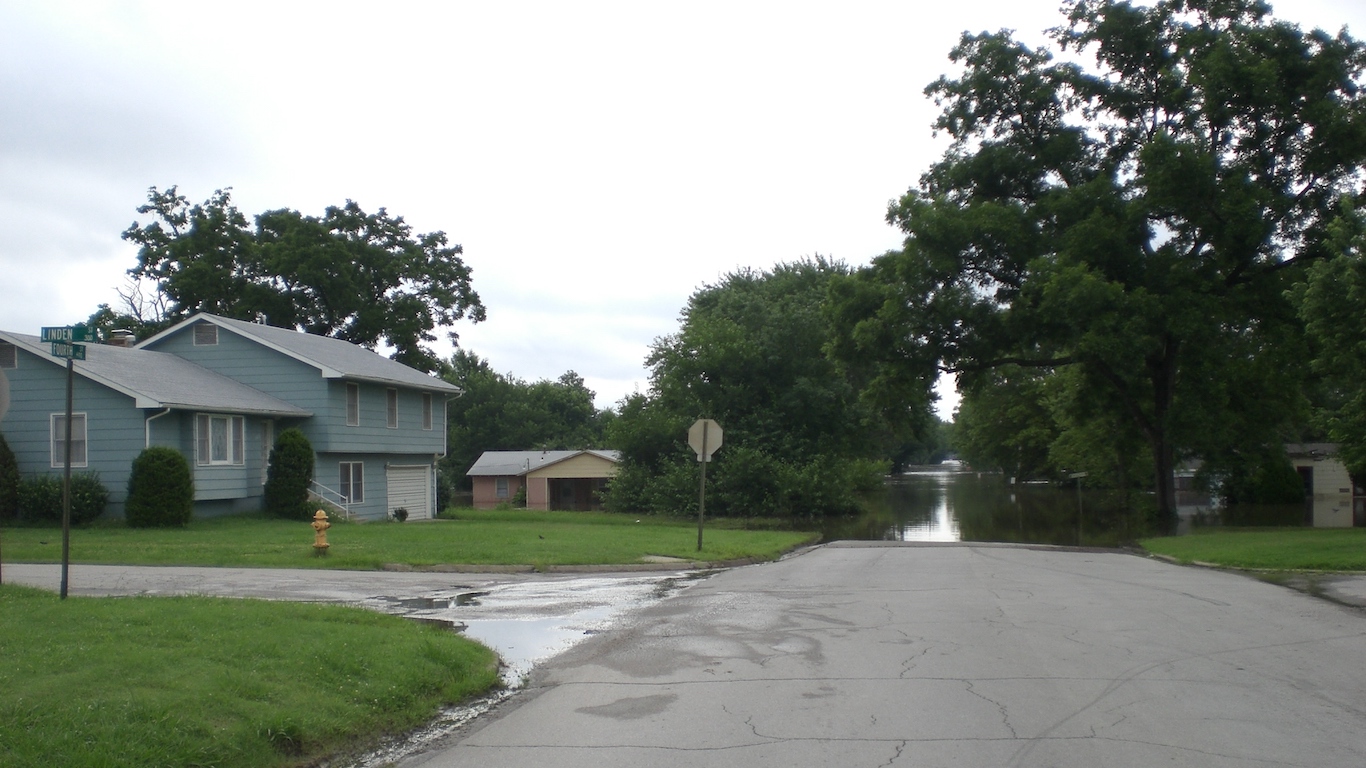
19. Coffeyville, Kansas
> Vacancy rate: 10.1%
> Vacant properties: 474
> 5 yr. population change: -2.1%
> Median home value: $56,100
Coffeyville, Kansas located just north of the state’s border with Oklahoma, has one of the highest shares of vacant properties in the country. A high share of vacant properties can be indicative of several social and economic struggles. In Coffeyville, nearly one in four residents are poor, a far larger share than is typical nationwide.
The town was once home to a number of companies and establishments, although it was best known for its brick and glass industries. Ball Brothers Glass Factory and Mason Fruit Jar Company, among others, once operated in the area. Most of these factories closed in the early 1900s. While this may have been a burden on the local economy, the city’s population continued to rise, peaking in 1960 with 17,382 residents. The city is now home to only about 10,000 residents.
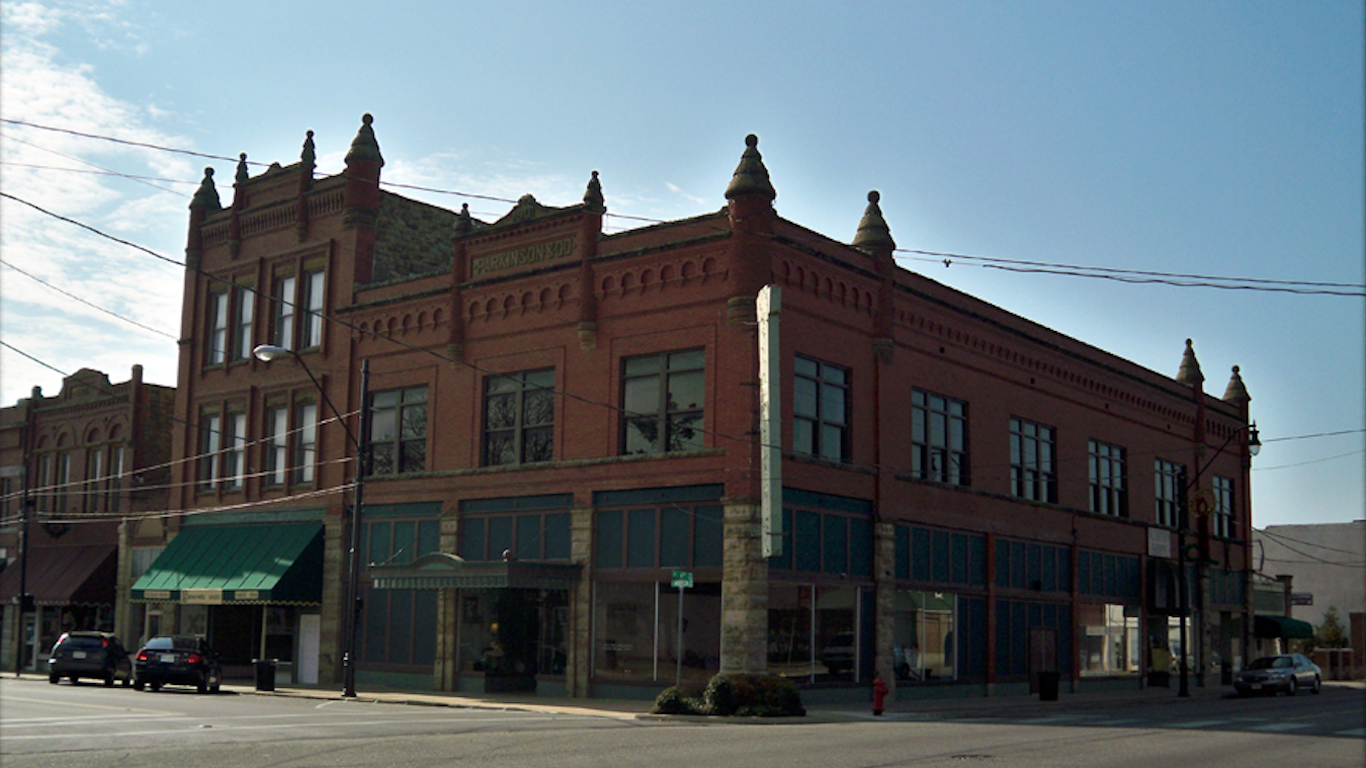
18. Okmulgee, Oklahoma
> Vacancy rate: 10.2%
> Vacant properties: 522
> 5 yr. population change: -1.7%
> Median home value: $64,700
More than one in 10 homes in Okmulgee, Oklahoma are vacant, a far greater share than the 1.6% vacancy rate nationwide. As is typical in areas with a large share of abandoned homes, Okmulgee is an economically depressed area. More than 28% of area residents live at or below the poverty line, well above the 15.6% national poverty rate.
Things may be turning around for the eastern Oklahoma city, however. Currently, there are more than a dozen projects in the works to revitalize the Okmulgee downtown area, which could attract new residents and employment opportunities. And while property values in most cities with exceptionally high home vacancy rates have been plummeting in recent years, the typical Okmulgee home has appreciated 6.4% in the last half decade.
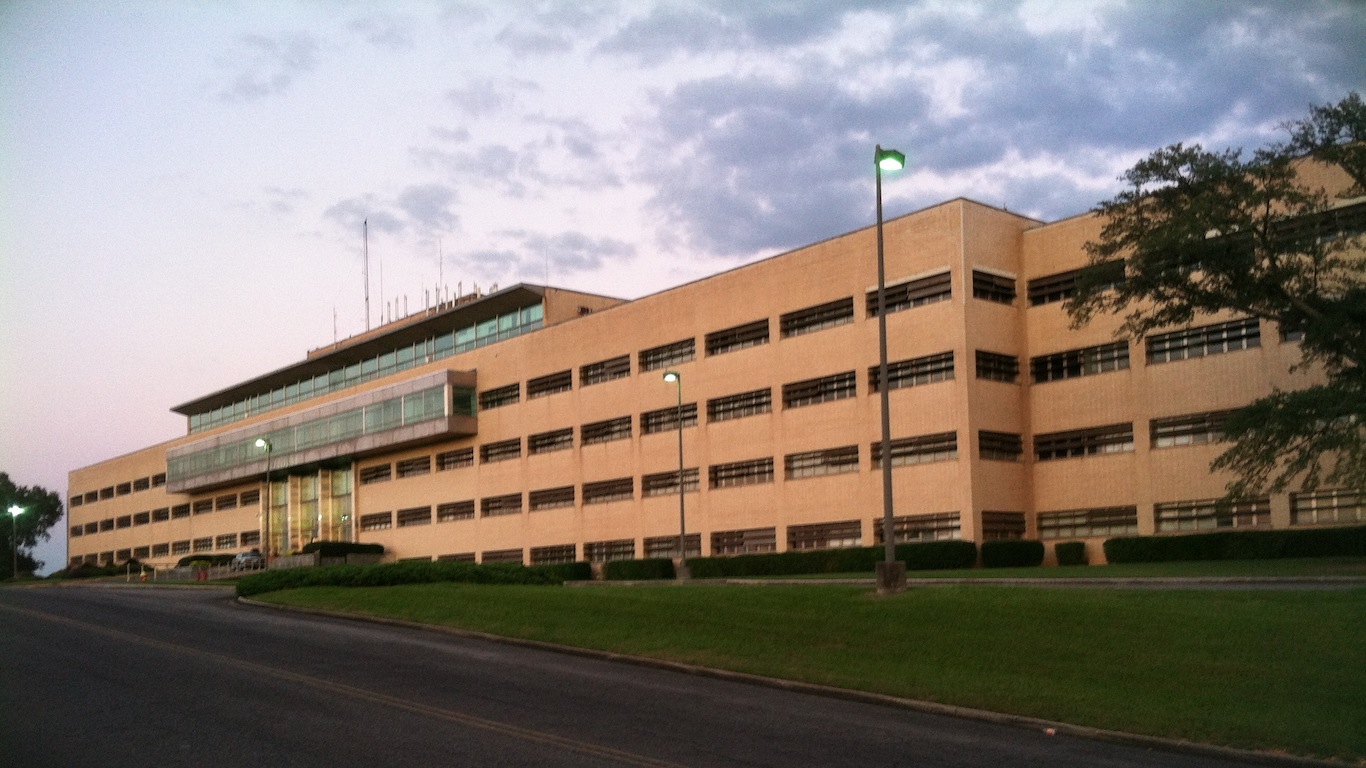
17. Fairfield, Alabama
> Vacancy rate: 10.4%
> Vacant properties: 403
> 5 yr. population change: -4.0%
> Median home value: $94,900
As is often the case in towns with a high vacancy rate, property in Fairfield is relatively cheap. The typical area home costs $94,900, roughly half of the median home value of $175,700 nationwide. Areas with high vacancy rates and cheap home values are also typically economically depressed and impoverished. About one in four Fairfield residents live at or below the poverty line, significantly worse than the one in six Americans who do nationwide.
Perhaps in part because of the city’s declining population and tax base, Fairfield — a city of about 10,000 people — is in dire financial straits and on the verge of bankruptcy. In an attempt to avoid Chapter 9, the city council recently voted unanimously to disband the city’s police department. Further exacerbating the city’s economic woes has been the recent loss of major retailers. With Wal-Mart, Sears, and Kmart all leaving the area recently, the city’s sales tax revenue further declined.
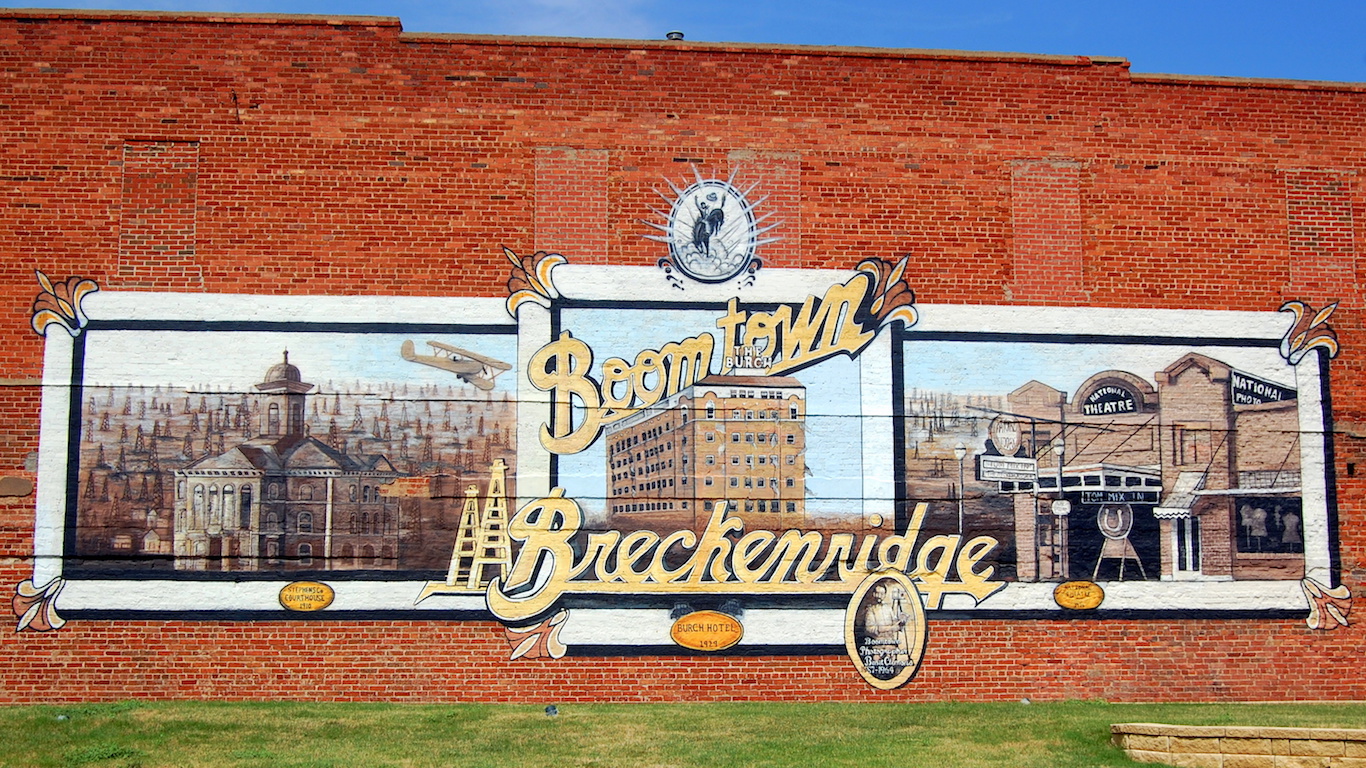
16. Breckenridge, Texas
> Vacancy rate: 11.2%
> Vacant properties: 298
> 5 yr. population change: 1.2%
> Median home value: $56,300
Few U.S. cities have a higher home vacancy rate than Breckenridge, Texas. More than 11% of area homes are effectively abandoned, a far larger share than the comparable 1.6% national share.
While in many U.S. cities with high vacancy the population is rapidly declining and property values are plummeting, Breckenridge is an exception. In the last half decade, the city’s population has increased slightly, by 1.2%. Improvements in the housing market have been even more dramatic. The typical area home is now worth nearly 12% more than its value five years ago. These trends suggest conditions may be improving in the north Texas city.
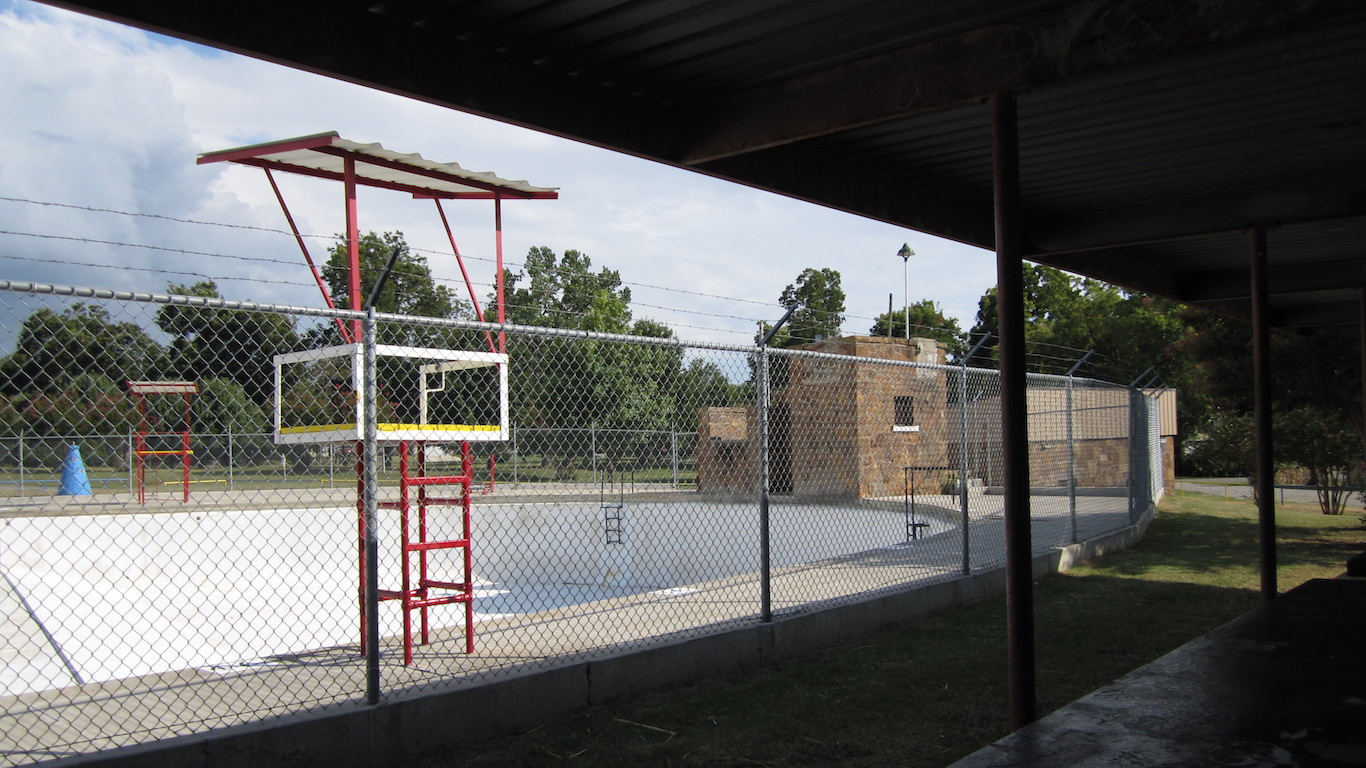
15. Holdenville, Oklahoma
> Vacancy rate: 11.5%
> Vacant properties: 312
> 5 yr. population change: 4.6%
> Median home value: $53,300
While prisons provide relatively high paying jobs, they are often detrimental to local economies.
The Davis Correctional Facility, which opened in Holdenville, Oklahoma in 1996, does not appear to have helped its home city very much. More than one-quarter of area residents live at or below the poverty line, well above the 15.6% national poverty rate. Additionally, 11.5% of area homes are effectively abandoned, the highest vacancy rate in Oklahoma.
[in-text-ad]
For some remaining Holdenville residents, homeownership has become slightly more profitable in recent years. The typical area home is worth $53,300 today, up 9.2% from five years ago. Over that same period, area population is up by 4.6%.
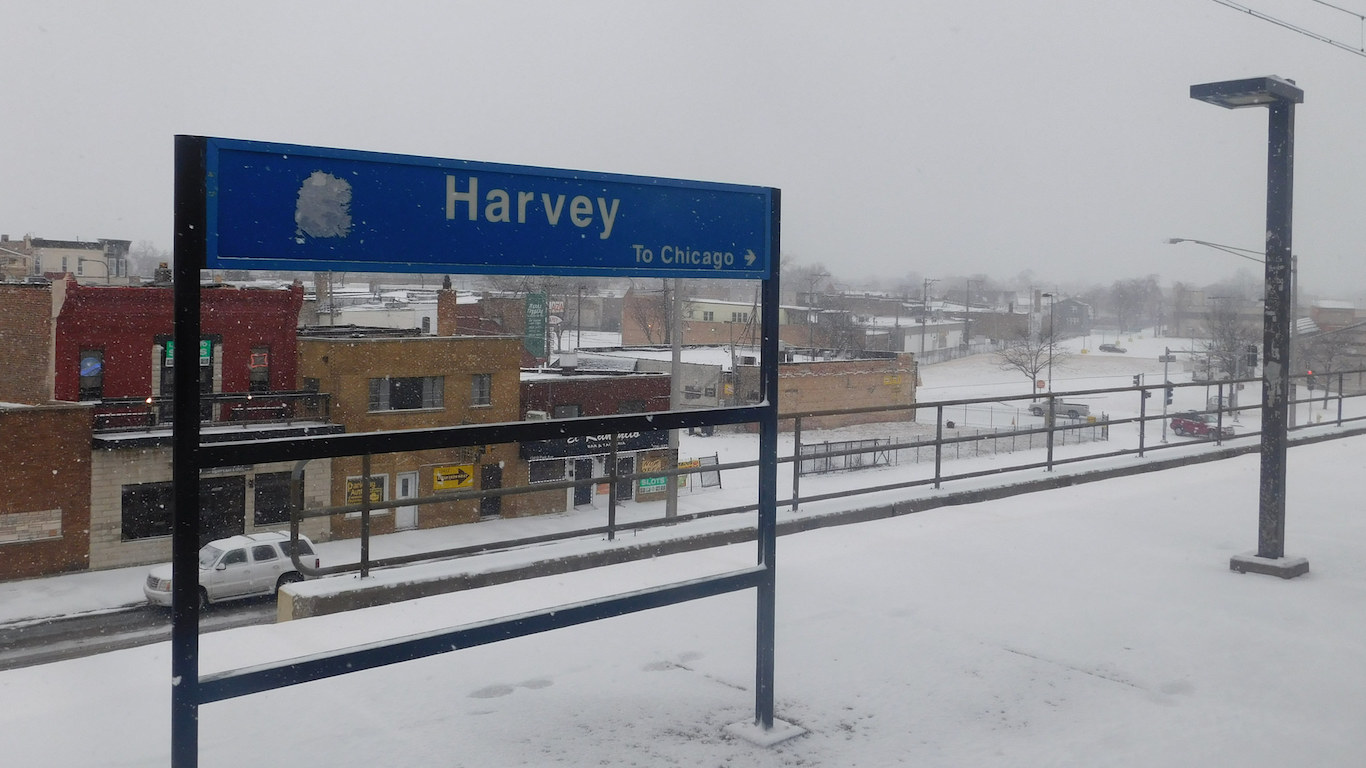
14. Harvey, Illinois
> Vacancy rate: 11.8%
> Vacant properties: 1,095
> 5 yr. population change: -9.9%
> Median home value: $81,000
More than 1,000 homes in Harvey, Illinois have been abandoned, or nearly 12% of all area homes. The city’s exceptionally high vacancy rate has likely exacerbated housing market problems in Harvey as home values have been plummeting in recent years. The typical area home is worth $81,000, 19.4% less than its value five years ago. Due in large part to declining property values, roughly one third of homes in Harvey are worth less than what is owed on them. As is often the case in areas with declining home values and high vacancy, people have been leaving the city. Over the last five years alone, Harvey’s population is down by about 10%.
The Chicago suburb municipality is facing financial hardship. According to findings of a recent audit, the city is on the brink of insolvency, likely the result of mismanagement.
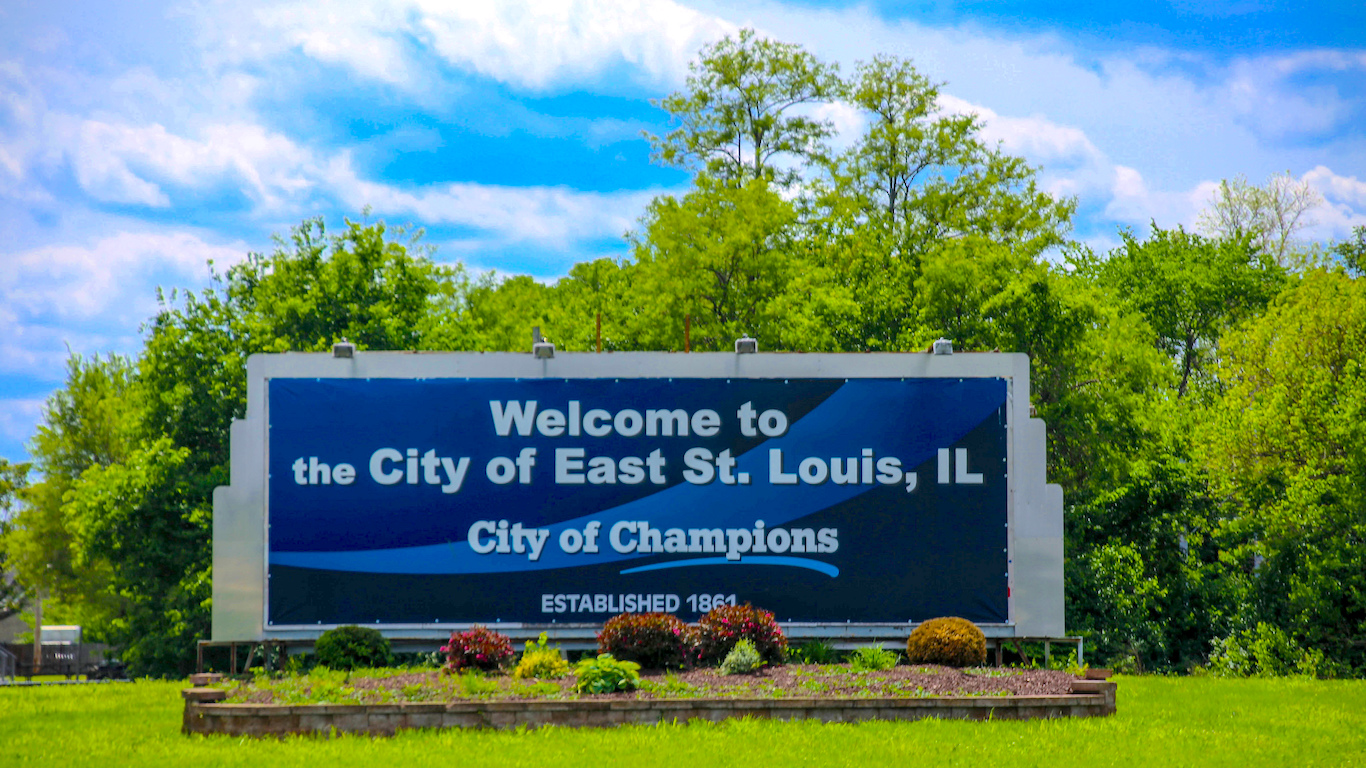
13. East St. Louis, Illinois
> Vacancy rate: 11.8%
> Vacant properties: 2,105
> 5 yr. population change: -8.1%
> Median home value: $57,000
East St. Louis, situated across the Mississippi River and the Missouri state border from St. Louis, has a higher share of vacant homes than any other city in Illinois. There are well over 2,000 abandoned homes in East St. Louis, or nearly 12% of all residential properties in the city. To many of those living in the city, homeownership may be more of a financial liability than a boon. Due to declining property values — home prices dropped 7.3% in the last half decade — more than 8% of East St. Louis homeowners owe more on their home than the property is worth.
A shadow of its former self, the city is one of many to struggle due to the manufacturing sector’s decline in the second half of the 20th century. The city lost more than 13,000 jobs between 1960 and 1987, largely due to plant shutdowns. The resulting urban decay led the U.S. Department of Housing and Urban Development to at one point name East St. Louis the “most distressed city in America.” The city is now home to only 27,000 people, down from a peak of more than 82,000 in 1950. In the last five years alone, the city’s population shrunk by 8.1%.
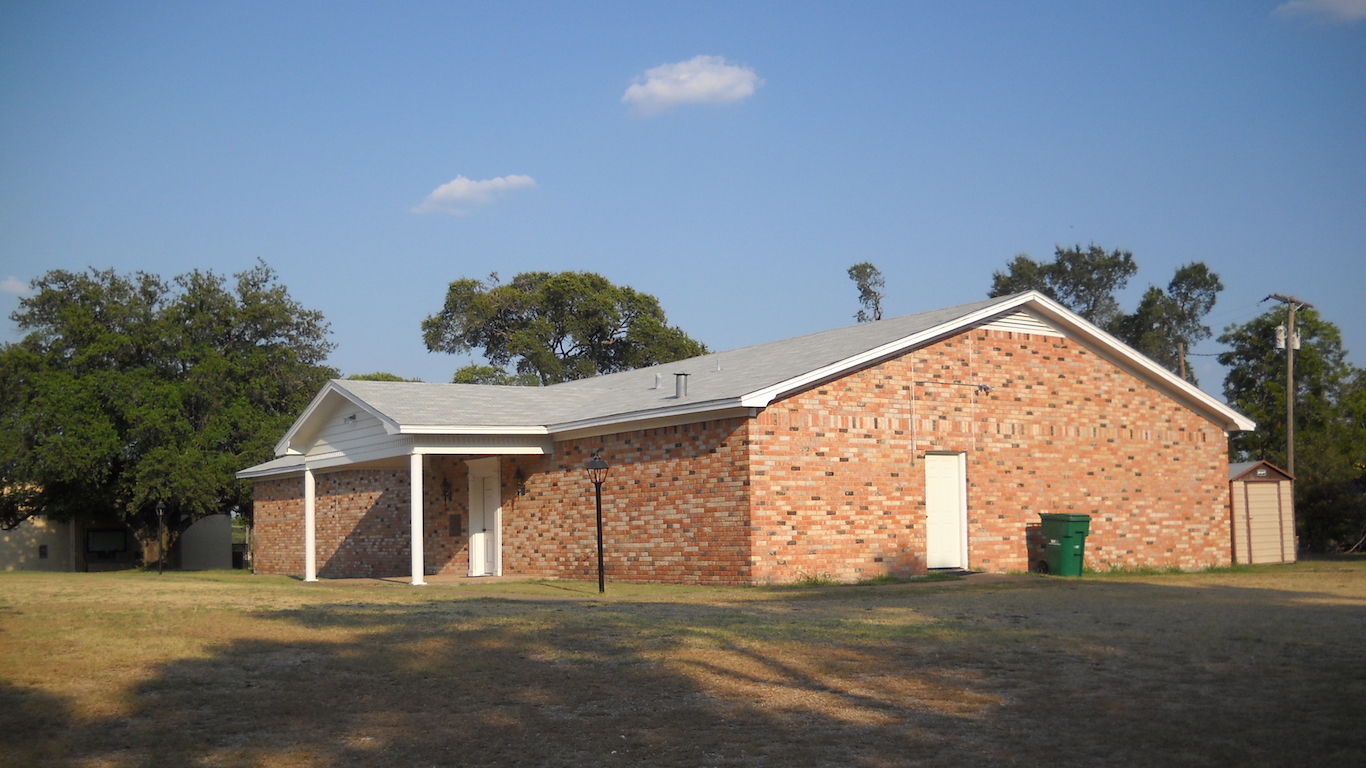
12. Marlin, Texas
> Vacancy rate: 11.9%
> Vacant properties: 320
> 5 yr. population change: -0.7%
> Median home value: $52,200
Marlin has a higher share of abandoned homes than any other city in Texas. Roughly 12% of homes in the area are vacant, a far higher share than the national home vacancy rate of 1.6%. Poor infrastructure in the central Texas town is likely not helping solve regional vacancy. The city’s water plant failed on Thanksgiving Day last year, leaving residents without tap water for a week. At a city council meeting earlier this year, residents pleaded with officials to address the city’s crumbling roads.
Like many U.S. cities with high vacancy rates, many Marlin residents are likely struggling. Well more than a third of area residents live at or below the poverty line, more than double the national poverty rate. Additionally, the median home value in the area is only $52,200, less than a third of the value of a typical American home.
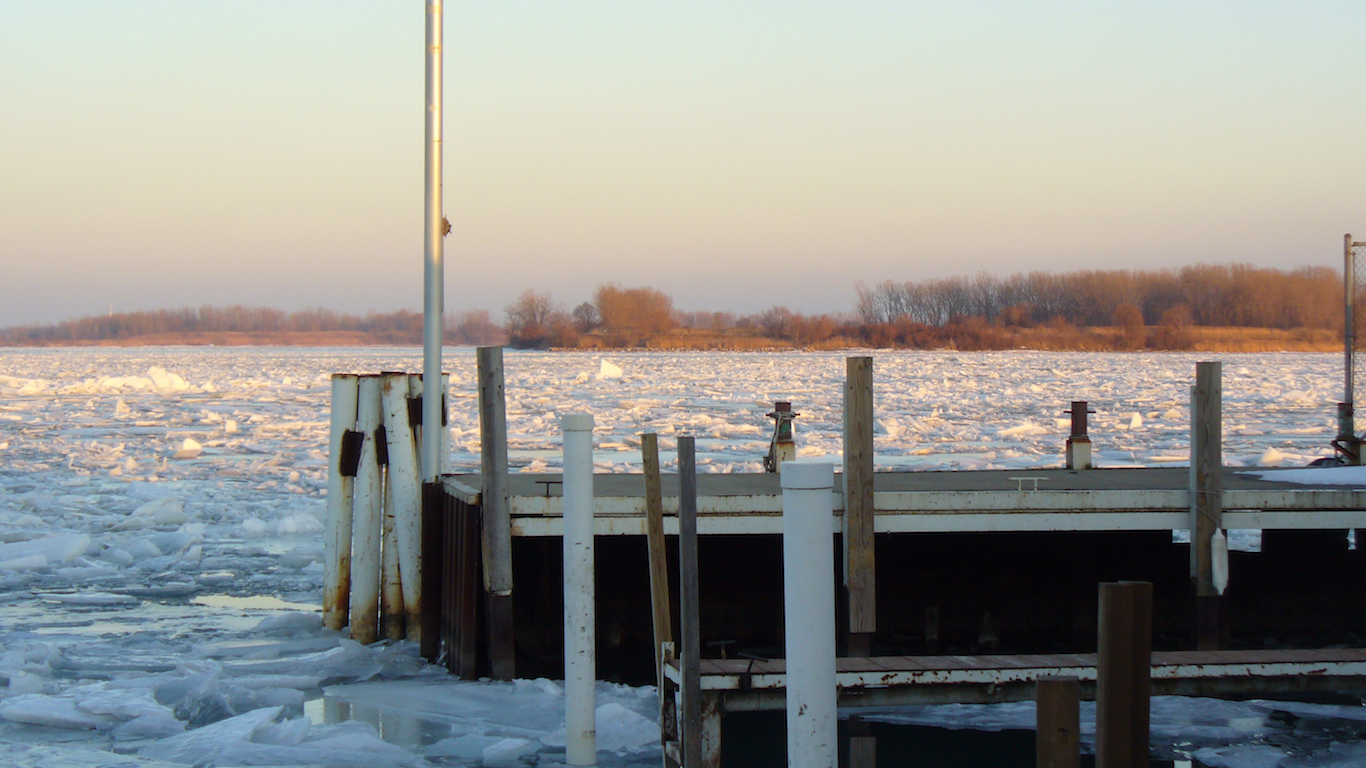
11. Ecorse, Michigan
> Vacancy rate: 12.1%
> Vacant properties: 515
> 5 yr. population change: -7.6%
> Median home value: $39,200
Ecorse, Michigan is part of the Detroit metropolitan area, and like many towns in the region, it is suffering from economic depression that seems only to be getting worse. The area’s already low median home value of $74,400 in 2009 fell to just $39,200 by 2014. Of the more than 4,800 towns and cities with available data for 2014, Ecorse is one of just 10 for which the typical home costs less than $40,000. About 29% of city residents live in poverty, nearly double the national poverty rate.
As is often the case in areas with a weak economy and inexpensive homes, Ecorse’s population is declining and a high share of its homes are vacant. The city’s population of 9,401 is down from 10,171 five years earlier, a 7.6% drop. About 12% of property in the area is vacant.

10. Inkster, Michigan
> Vacancy rate: 12.4%
> Vacant properties: 1,143
> 5 yr. population change: -8.4%
> Median home value: $51,700
An estimated 12.4% of homes in Inkster, part of the greater Detroit metropolitan area, lie vacant, more than seven times the national vacancy rate. As is frequently the case in areas where a large share of property is abandoned, the Inkster housing market is clearly struggling, and conditions appear to be getting worse. In the last five years alone, the area’s median home value fell from $96,700 to $51,700, each well below the corresponding U.S. values at the time.
[in-text-ad]
An area’s housing market is usually closely tied to its economy, and Inkster, like much of the Detroit region, is in dire economic straits. Across the country, 15.6% of the population lives at or below the poverty line. In Inkster, a whopping 37.0% of the population does.

9. Detroit, Michigan
> Vacancy rate: 14.3%
> Vacant properties: 37,771
> 5 yr. population change: -24.1%
> Median home value: $45,100
There are approximately 38,000 vacant properties in Detroit, by far the most of any U.S. city. This is more than double the combined vacant properties in Baltimore and St. Louis, which have the second and third most abandoned residences, respectively. Detroit’s long-term economic struggles, with the decline in regional auto manufacturing representing just one of the city’s problems, has led to a long-term population loss. Since peaking in the 1950s, the greater Detroit area’s population has dropped by half.
The housing market collapse of a few years ago appears to have further exacerbated Detroit’s population drain and weakened housing market. Over the past five years, Detroit’s population fell from about 916,000 to under 700,000. In 2009, the typical home in Detroit cost $85,400 compared to a national median home value of $185,400. By 2014, the median Detroit home price fell by nearly half to just $45,100, compared to a national median value of $175,700.

8. River Rouge, Michigan
> Vacancy rate: 14.5%
> Vacant properties: 491
> 5 yr. population change: -10.6%
> Median home value: $36,800
Within commuting distance of Detroit, River Rouge is one of many Rust Belt cities with a dwindling population and a near-nation leading home vacancy rate. There are 491 vacant homes in River Rouge, Michigan, equal to nearly 15% of all homes in the area. In the last five years, the city has lost 10.6% of its population, and home values have plummeted by 43.6%.
Much like Flint, Michigan, roughly an hour to the north, River Rouge residents are currently living amidst an environmental and public health crisis. There are more than 50 major industrial operations in the city, including a coal-fired power plant that discharges more sulfur dioxide than is allowed by the Environmental Protection Agency. As a result, air quality in the area is poor, and residents are suffering. Michigan has the highest asthma incidence in the country, and in the Detroit metro area, which includes River Rouge, asthma is roughly 33% more common than it is statewide. The area’s health issues may have contributed to its persistent high regional home vacancy.
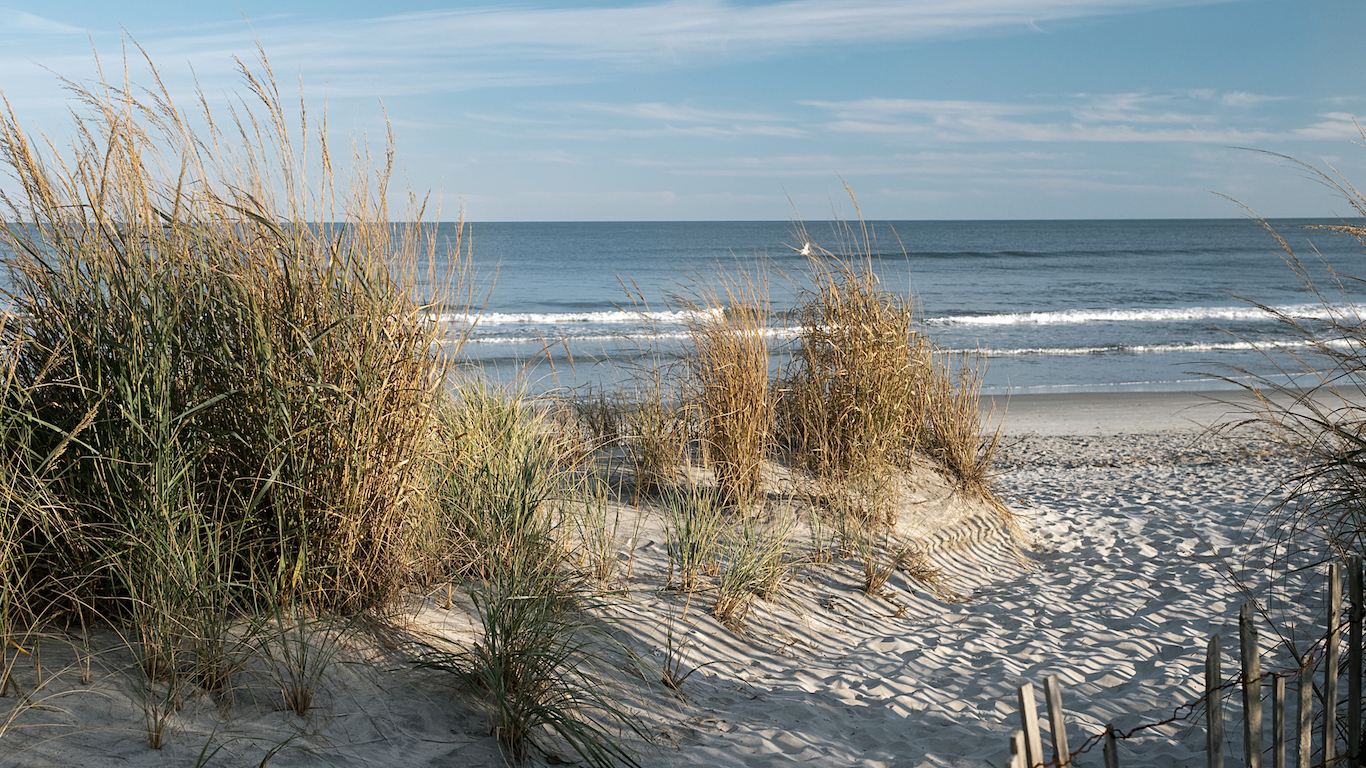
7. Brigantine, New Jersey
> Vacancy rate: 15.2%
> Vacant properties: 1,681
> 5 yr. population change: -25.8%
> Median home value: $369,700
While Brigantine was voted one of the best places to live in New Jersey by New Jersey Monthly in 2008, in recent years the town has suffered from economic decline and population loss. Brigantine is an island city off the New Jersey coast, and in 2012 it was hit particularly hard by Superstorm Sandy, the largest Atlantic hurricane on record. Brigantine sustained substantial property damage, with the value of a typical home falling by roughly $80,000 since 2009. As a result of the decline in property value, 9% of all homes in Brigantine have underwater mortgages, meaning they owe more on their homes than the market value of their property. Nationwide, fewer than 1% of all homes have underwater mortgages.

6. Highland Park, Michigan
> Vacancy rate: 15.2%
> Vacant properties: 2,128
> 5 yr. population change: -25.1%
> Median home value: $39,100
Highland Park is one of many Michigan towns on this list which have been gutted by employment declines in the the Detroit region. Highland Park was hit especially hard. More than 15% of area homes have effectively been abandoned, and the area lost more than a quarter of its population in the last five years. Highland Park’s high vacancy rate is punctuated by rapidly declining property values. The typical area home is worth only $39,100, or about 44% less than its worth in 2009.
As is the case in many areas with high vacancy rates, municipal services are facing serious fiscal stress. The city’s school district faced a $7.8 million budget shortfall at the end of its 2016 fiscal year and was forced to close the local high school at the end of the 2015 academic year.

5. Flint, Michigan
> Vacancy rate: 15.5%
> Vacant properties: 8,992
> 5 yr. population change: -12.1%
> Median home value: $36,700
Home to roughly 200,000 people at its peak in 1960, Flint’s population has since declined by nearly half. The city is now home to just over 100,000 people, about 12% fewer than only half a decade ago. The mass exodus has had serious implications for Flint’s housing market. More than 15% of area homes have effectively been abandoned, and property values have plummeted by 43.1% over the last five years.
[in-text-ad]
Flint’s population decline and high vacancy rate are largely the byproduct of steep declines in the area’s once vibrant auto manufacturing sector. General Motors previously had multiple plants in the city, employing more than 82,000 people at peak in 1955. The number of GM employees declined steadily through the decades, and as of 2008, GM employed only 7,100 people in the area. More recently, the city received national attention due to lead contamination in its water supply. Population declines resulting from this public health crisis are not yet known.
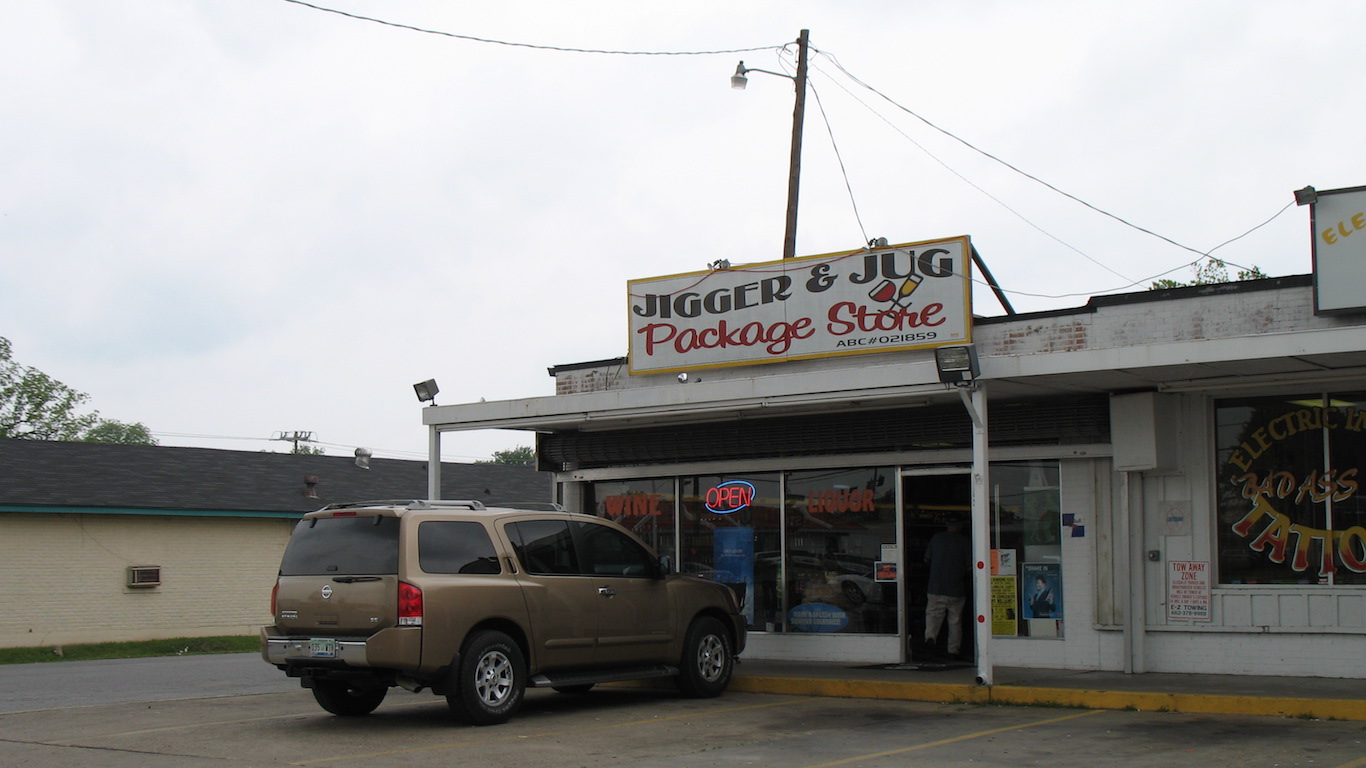
4. Greenville, Mississippi
> Vacancy rate: 15.7%
> Vacant properties: 883
> 5 yr. population change: -7.6%
> Median home value: $76,200
Greenville is located in the Mississippi Delta, a floodplain along the Mississippi River in the northwest part of the state. While the Delta once flourished with prosperous agriculture and low-tech manufacturing sectors, foreign competition and mechanization in recent years have led to economic decline, and job and population losses. The Delta’s population is close to half of what it was in 1940, and in the last five years the number of Greenville residents has fallen from 36,264 to 33,518. Like in many rural towns, residents are likely leaving for denser, more urban cities. An estimated 15.7% of residential properties in Greenville have been left vacant, approximately 10 times the national vacancy rate.
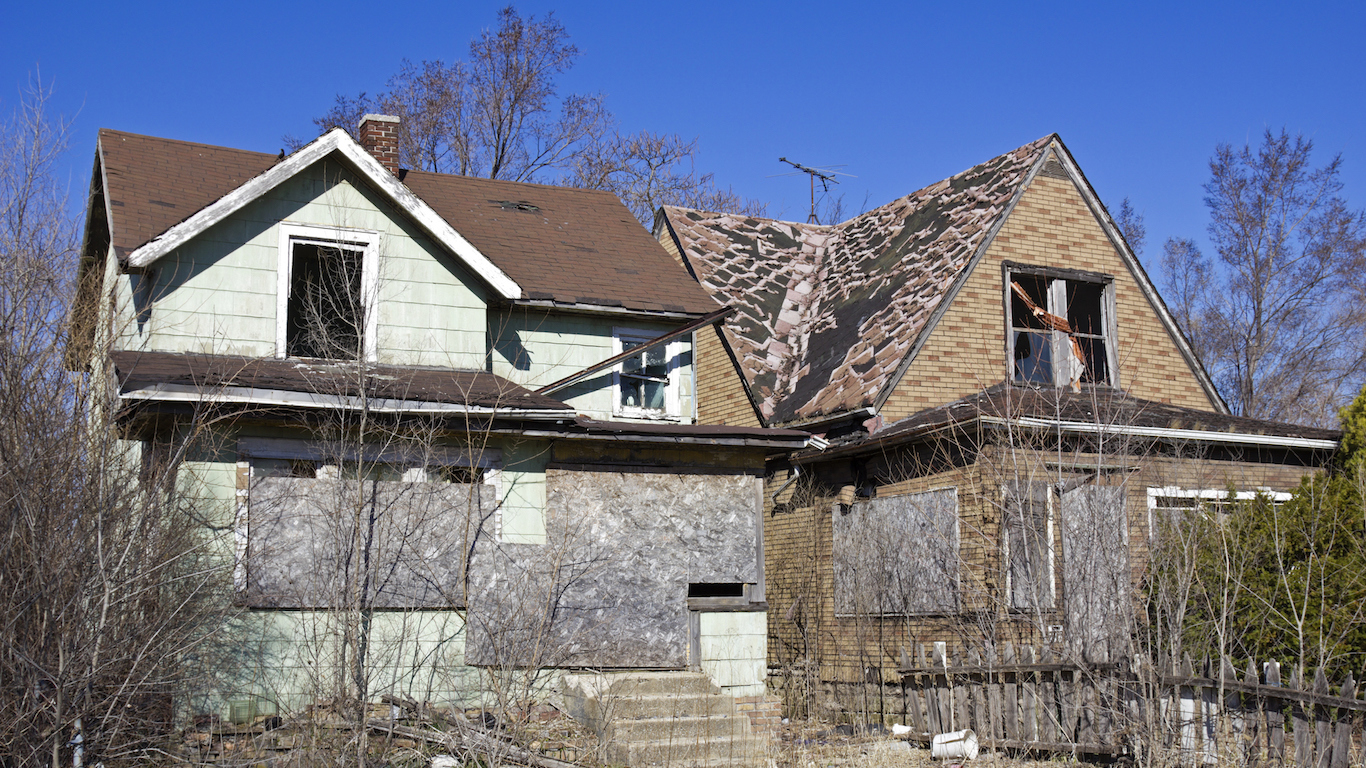
3. Gary, Indiana
> Vacancy rate: 20.3%
> Vacant properties: 6,505
> 5 yr. population change: -17.9%
> Median home value: $65,500
Once the second largest city in Indiana, Gary is one of many Midwestern towns whose industrial economy has declined as cheap steel from outside of the country reduced demand for U.S. steel. The population has fallen by more than 55% since its 1960 peak. Today, more than one in five homes are vacant, the third largest such share of any city or town in the country. Over the five years ending in 2014, real estate values fell from $69,400 to $65,500. At the same time, poverty also rose from 33.4% to 38.7%, likely hurting area home values. The price of a typical home in Gary fell by 5.6% over the same period. More than one out of every 200 properties are in foreclosure.
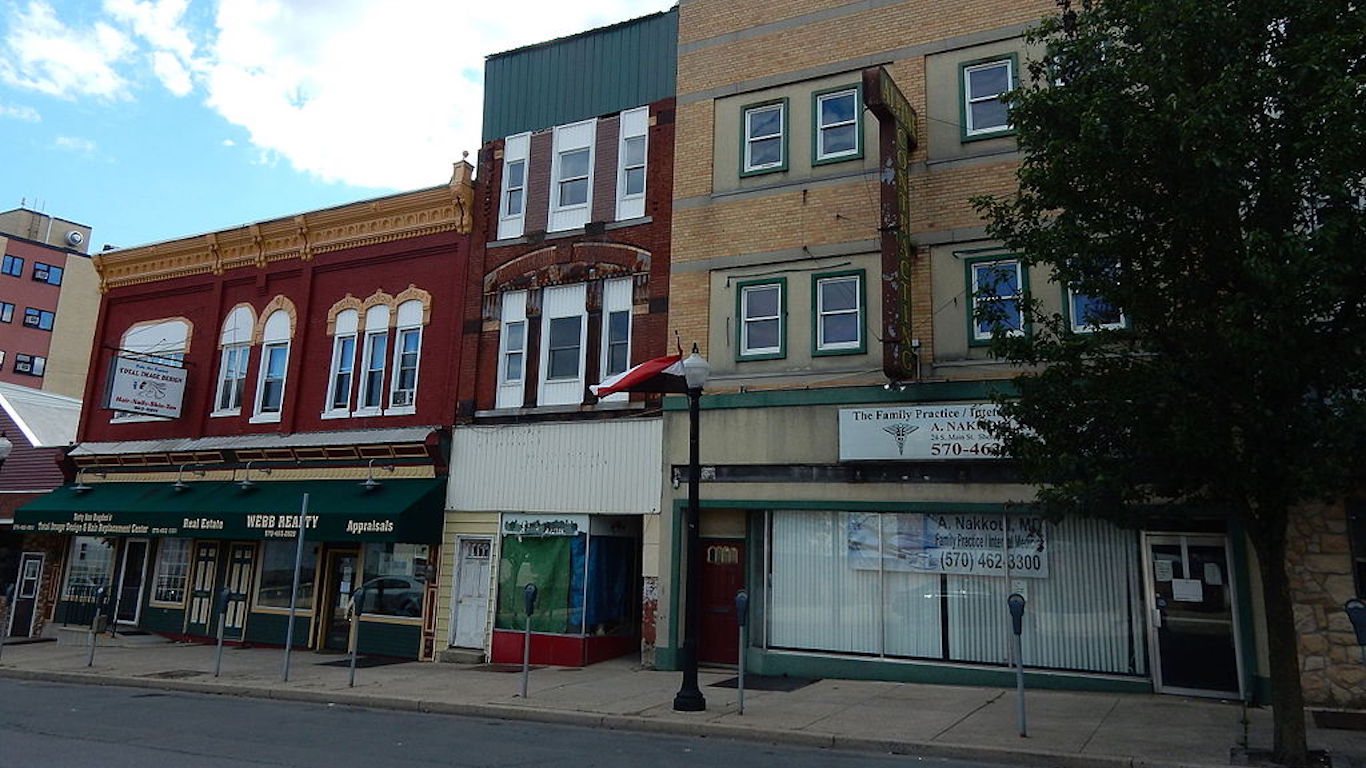
2. Shenandoah, Pennsylvania
> Vacancy rate: 21.3%
> Vacant properties: 692
> 5 yr. population change: -3.6%
> Median home value: $31,900
Following the discovery of anthracite coal in the southern part of town in the early 19th century, Shenandoah became instrumental in meeting coal demand at the time. The city grew into one of the most diverse economies in Pennsylvania, finally incorporating in 1866. After cheap natural gas and other sources of energy began to reduce the demand for coal a more than a century later, however, mines became less profitable and many started to close. Like the majority of small mining towns in the Pennsylvania coal region, Shenandoah entered economic decline. The population today is less than one-fifth of what it was in 1910, and it has shrunk by 3.6% over the five years ending in 2014. An estimated 21.3% of all residential properties in Shenandoah today are vacant, the second largest share in the country.
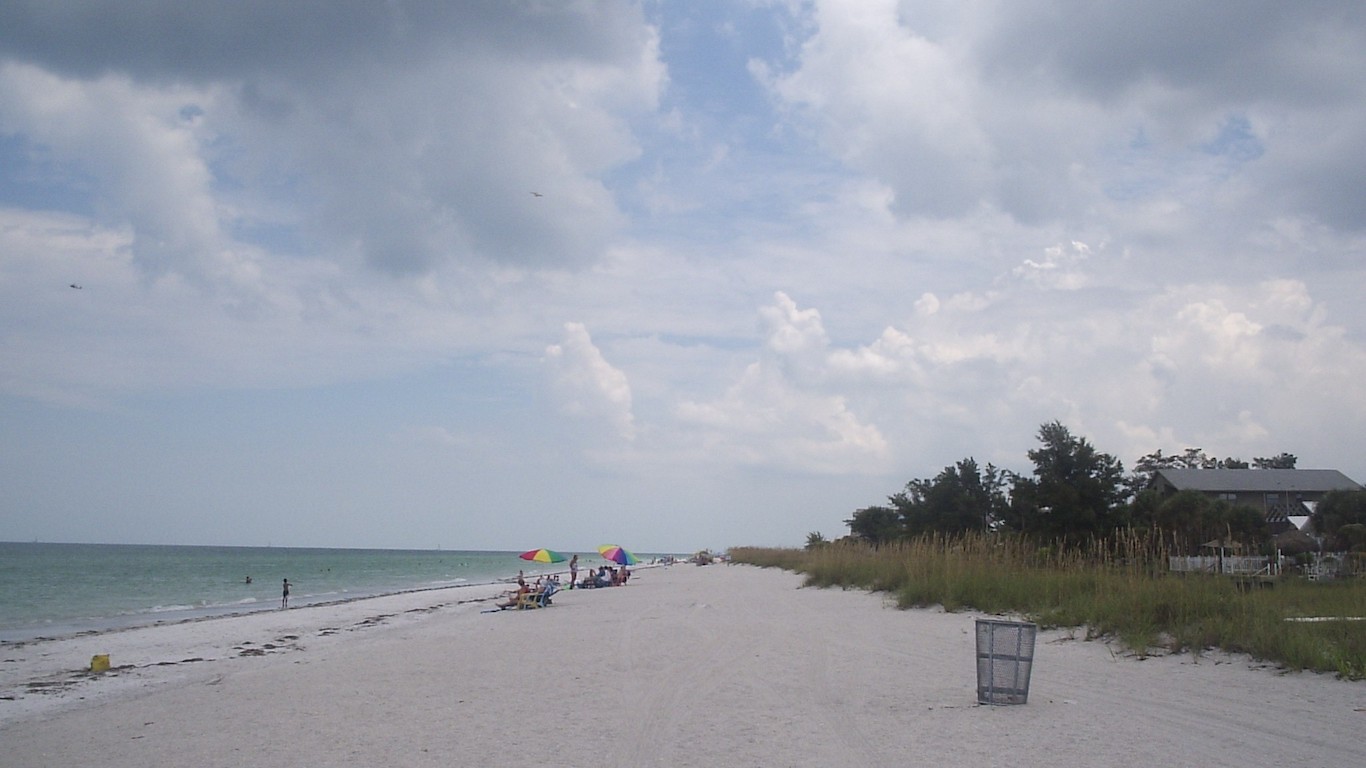
1. Indian Rocks Beach, Florida
> Vacancy rate: 26.1%
> Vacant properties: 1,403
> 5 yr. population change: -19.4%
> Median home value: $385,100
Indian Rocks Beach is the only city in the country where more than one in four residential homes are vacant. However, the city shares some characteristics with a number of popular vacation destinations where vacancy rates are also relatively high. For example, Indian Rocks Beach has oceanfront access and relatively high property values.
Though some of the city’s 1,403 vacant homes may be vacation properties, there are also multiple indicators to suggest many of these homes have indeed been abandoned. In the last five years, the city’s population has decreased by 19.4%, even while the country’s population as a whole grew by 4.2%. Additionally, in the last five years, the home values in the region declined by 32.4% over the last five years.
Retirement can be daunting, but it doesn’t need to be.
Imagine having an expert in your corner to help you with your financial goals. Someone to help you determine if you’re ahead, behind, or right on track. With SmartAsset, that’s not just a dream—it’s reality. This free tool connects you with pre-screened financial advisors who work in your best interests. It’s quick, it’s easy, so take the leap today and start planning smarter!
Don’t waste another minute; get started right here and help your retirement dreams become a retirement reality.
Thank you for reading! Have some feedback for us?
Contact the 24/7 Wall St. editorial team.